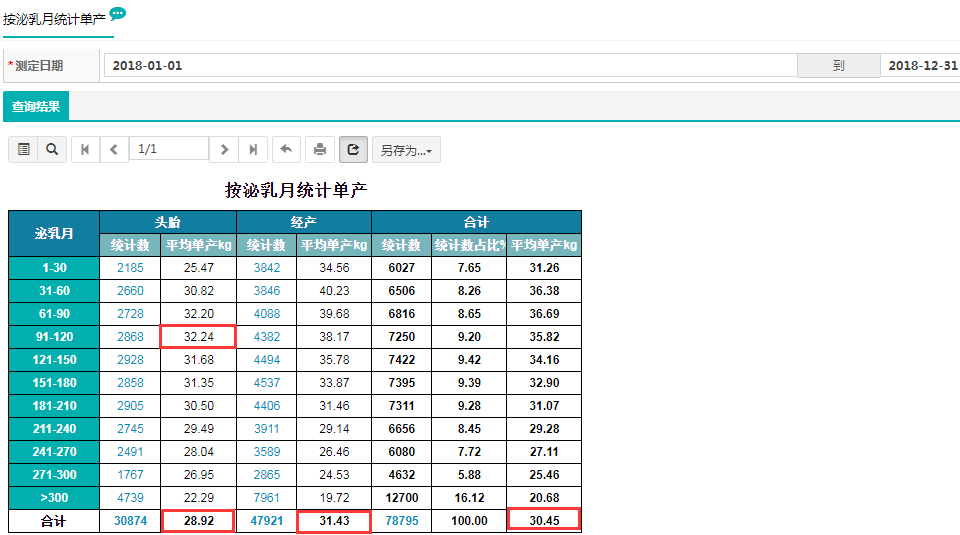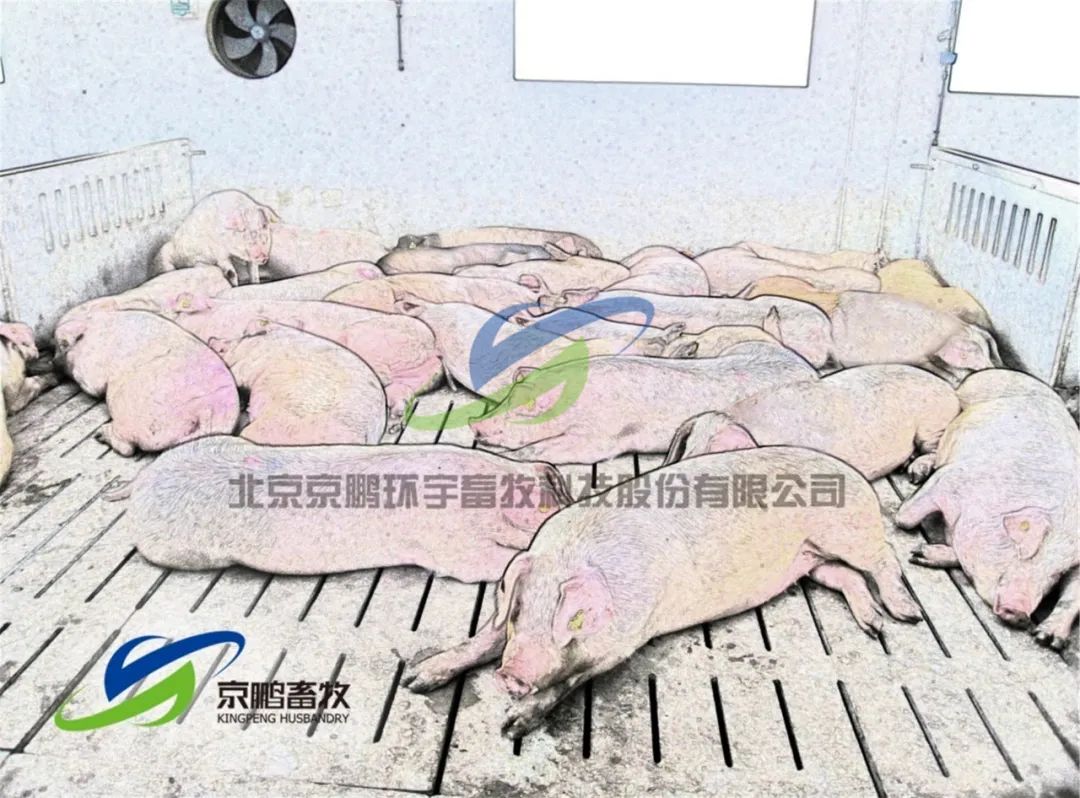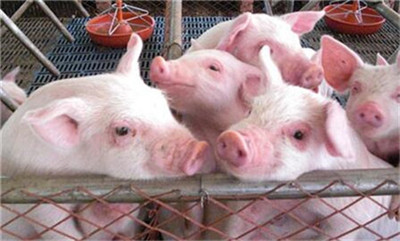How to improve the level of pasture management through data management [breeding article]
It is well known that the breeding level of commercial pastures is the key factor that determines the development of pastures, and the breeding level of pastures is affected by many factors. Objective factors include: genetic level, nutrition level, cattle health level, external environment. Subjective factors include: the level of on-site operation of breeding personnel, whether the breeding process is reasonable, and the executive ability of breeding process.
The following is a case study of a large farm improving its breeding level through the use of Dairy Star Farm Management system.
(you can click on the following pictures to enlarge)

The annual yield measurement records in 2018 and 2019 were segmented according to the postpartum days, and the weighted average per unit yield was determined accordingly, and the average yield distribution in 2018 and 2019 was calculated. The per unit yield of the farm increased by 2kg in 2019 compared with 2018, the peak lactation of first-born cows in 2018 was delayed in 2019, and the peak milk of first-born cows in 2019 was higher than that in 2018. 1.5Kg increased.
The 21-day pregnancy rate increased by 4 percentage points in 2018 and 2019 (the results of pregnancy tests are unknown in the three estrus periods after 2019, so there are no statistics). The main improvement point is reflected in the increase in the rate of oestrus disclosure, rising from 56.34% to 69.17%. Practice has proved that in the case of heredity (in the case of no outsourcing in the next two years, there is little difference in the genetic level of adult cows) and other objective factors, how to make more cattle estrus breeding is the key to improve pasture reproduction.
It is suggested that the pasture breeding department should pay attention to the following process in order to find a suitable scheme to improve the breeding level of this farm.
Pay attention to the progress of stage reproduction (21-day pregnancy rate)
Pay attention to the completion of postpartum first mating and the influencing factors of first mating
Postpartum estrus and pregnancy (VWP=50)
Estrus: September calves are only in estrus between 30-85 days postpartum (including mating at this stage and unsuitable breeding due to postpartum uterine environment but showing estrus).
Breeding: the actual breeding proportion of calves produced in September is only between 30-85 days.
Conception: the first mating conception rate of calves between 30-85 days in September.
Within 85 days after delivery, healthy cattle will show obvious / recessive estrus under the regulation of their own hormones or artificial hormones. If the proportion of estrus is less than 95%, it is recommended that the pasture consider the following points:
1) whether the actual lack of dry milk / perinatal days led to poor physical condition during calving, and postpartum hormone levels could not be recovered.
2) whether it is due to the influence of postpartum disease for the first time
As newborn cattle are prone to disease (such as uterine inflammation, mastitis, uterine inflammation, placenta retention, hoof disease, etc.), resulting in low feed intake, unable to meet the nutritional needs of dairy cows, aggravating the risk of negative energy balance.
It has been widely accepted that negative energy balance, like inflammation, can hinder follicular development and maturation. The pathogenesis of low fecundity symptoms is very complex. The interference of hypothalamus-pituitary-gonadal axis can lead to the disturbance of endocrine signals and delay the repair of postpartum ovary in dairy cows. Biochemical parameters related to negative energy state, such as non-esterified fatty acids (NEFA), can contact follicular fluid and reduce the developmental ability of oocytes.
3) whether there is a problem with the estrus cycle
Mating interval:
1-3 days is compound, the proportion is high, there may be inaccurate identification of estrus, follicular cysts and delayed ovulation and other reasons, it is recommended that the proportion of compound is 0. The problem cow suggests to check the details and then analyze it in detail.
4-17 days is short estrus, and the high proportion of mating may be caused by the failure of execution at the same time. It is recommended that the proportion of short-term breeding should be controlled within 5%.
18-24 days is a normal cycle of estrus, and the proportion of recommended reference is more than 45%, which may be due to the lack of estrus identification and observation.
25-35 days are abnormal relapse cattle. There are many reasons, such as: early embryo death, oestrus omission in diestrus cattle, insufficient luteal secretion in pregnancy, failure of the procedure in the same period and so on. It is recommended that the proportion is less than 10%.
Most of the cattle returning to estrus at 36-48 days were estrus cattle after pregnancy test and simultaneous treatment, and a few of them were not observed in the last estrus. The recommended proportion is less than 25%.
≥ 48 days showed that the existence of return was not observed, and the empty cattle were not dealt with in time. The recommended proportion is less than 3%.
4) whether the process in the same period is reasonable
There are two main simultaneous processes that are mostly used by ranches:
New-born cattle PG PG GnrH PG GnRH TAI
Interval: 14d, 12d, 7d, 56h and 16h.
Empty cow GnRh PG GnRH TAI
The interval was 7 days, 56 hours and 16 hours.
Studies have shown that the conception rate of artificial insemination is 1-3 percentage points higher than that of timing insemination. If there is too much difference, it is recommended to consider whether there is a problem in the same process, whether the corpus luteum is not completely dissolved, or whether there are omissions in the same step. It is suggested that we should try to add a shot of PG to 0789 on the basis of traditional synchronous ovulation.
II related experiments found that the pregnancy rate of single insemination in the two-injection group was 9.45% higher than that in the one-injection group (37.6% in the two-injection group and 34.4% in the one-injection group). Therefore, adding an injection of PG to the ovulation synchronization program can increase the pregnancy rate by about 10%, mainly improving the fecundity of multiparous cattle.
5) whether the first mating is timely or not
The 42 and 100 weighted averages and the 69 and 73 averages are both 71. Combined with the above two pictures, the average first mating days is 71 days to meet the reference value, but the first mating distribution is not concentrated enough, there may be some problems, such as leakage, simultaneous program failure and first mating execution standards, and so on. It is suggested that there is a large deviation between the stage analysis and the average first mating days.
Pay attention to the ratio between the timeliness of pregnancy test and the loss of each pregnancy test
From the above picture, it can be seen that the initial inspection at 30 days, the first reexamination at 60 days, the second reexamination at 178 days, and the reexamination before dry milk at 219 days on average, the second reexamination was delayed. The loss ratio of pregnant cattle reported in this year was analyzed and calculated as follows: miscarriage before each pregnancy test and empty pregnant cattle / last pregnancy test. Because the initial examination is early and the accuracy is low, it is recommended to pay attention to the early embryo death and the accuracy of pregnancy test.
As the breeding work involves many interactions, resulting in many influencing factors, so specific analysis is still needed for different problems. I hope the content shared above can provide you with the direction of analysis.
Author: Bao Jie, technical expert of Beijing Xiangzhong Zhimu Technology Co., Ltd.
References:
I. MASTITIS and FERTILITY_5_metabolism story_LR by elKe ABBeloos
II. J Dairy Sci. 2015 Dec;98 (12): 8644-54. Doi: 10.3168/jds.2015-9353.
- Prev

How to make sows "obedient" in front of intelligent feeding station "Pig Training Manual" came
How to make sows "obedient" in front of intelligent feeding station "Pig Training Manual" came
- Next

How many times a year do pigs reproduce during the pig breeding cycle?
How many times a year do pigs reproduce during the pig breeding cycle?
Related
- On the eggshell is a badge full of pride. British Poultry Egg Market and Consumer observation
- British study: 72% of Britons are willing to buy native eggs raised by insects
- Guidelines for friendly egg production revised the increase of space in chicken sheds can not be forced to change feathers and lay eggs.
- Risk of delay in customs clearance Australia suspends lobster exports to China
- Pig semen-the Vector of virus Transmission (4)
- Pig semen-the Vector of virus Transmission (3)
- Five common causes of difficult control of classical swine fever in clinic and their countermeasures
- Foot-and-mouth disease is the most effective way to prevent it!
- PED is the number one killer of piglets and has to be guarded against in autumn and winter.
- What is "yellow fat pig"? Have you ever heard the pig collector talk about "yellow fat pig"?

